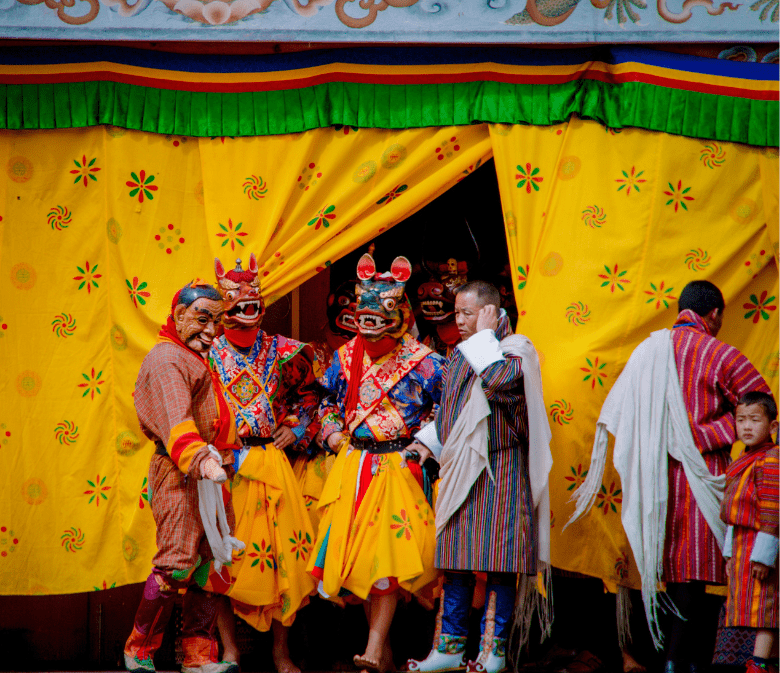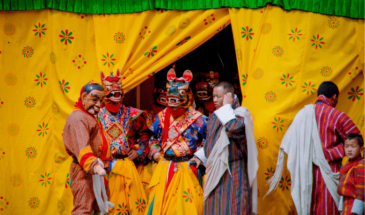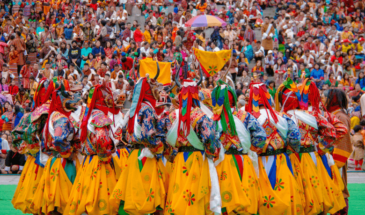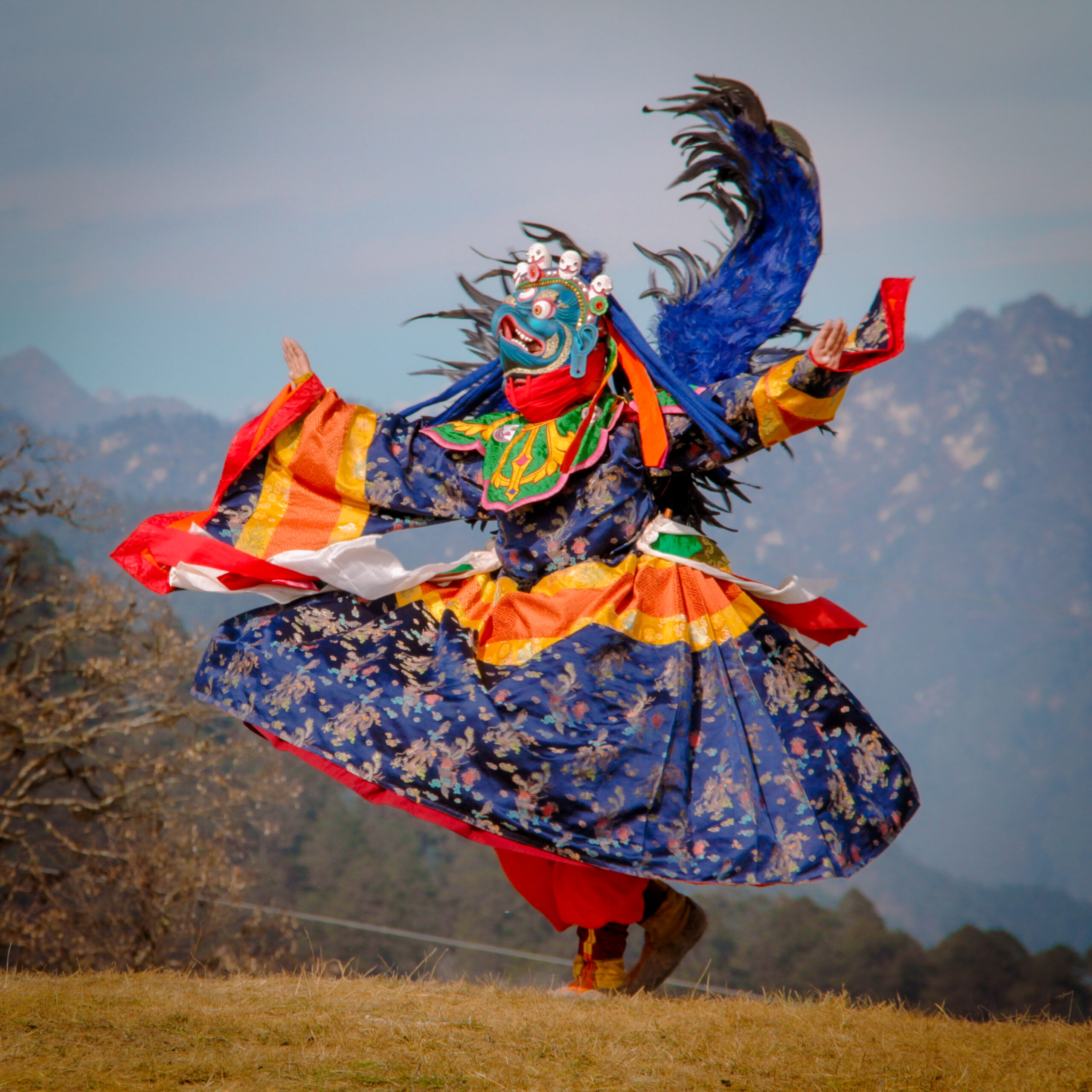- Overview
- Trip Outline
- Trip Includes
- Trip Excludes
- Gallery
- Booking
- FAQ
Thimphu festival is one of the most popular festivals of Bhutan. It attracts a large number of people from all over the country. The festival lasts for 3 days and witnesses traditional performances by monks and A highlight of this festival is the Tsechu of Cham dancing, where masked dancers from various communities perform their own fables, which have been passed down through generations.
The Tshechu is a festival that has been celebrated in Bhutan for centuries. It consists of dances, rituals and sacred masked dances.
Itineraries
Day 1
Fly in Paro, Bhutan - Thimphu
Welcome to Bhutan. On a clear day, one will experience breathtaking views of major Himalayan peaks, Jomolhari and Jichu Darkey in Bhutan from your flight. Upon arrival Bhutan's first gift to you will be clean fresh mountain air. Obtain your Bhutan visa which will be pre-paid, and after clearing Immigration and Customs, you will be met outside at the exit point by Bhutan Sky Trails representatives and escort you around for the sightseeing, onward to your hotel.
Visit Ta Dzong (National Museum), which towers above the Paro Dzong and viewing its well-interpreted collection of historic artifacts that makes a great prologue to the journey yet to come.
Visit Paro Dzong. This massive fortress is located in the Paro valley and is approached by a gently sloping flagstone road and a beautiful wooden bridge roofed with shingles and abutted by two guardhouses. Today, the Dzong is the Administrative seat of the Paro district and it also contains a state monastic community of about 200 monks. The central tower ("Utse") of the Dzong is one of the most stunning in Bhutan with its superb woodwork. The Dzong was built in 1646 A.D.
Day 2
Paro - Phobjikha
After breakfast you will embark on 5 – 6 hour journey to Phobjikha, a beautiful glacial valley famous for its biodiversity. Phobjikha is also popular for the endangered Black-necked Cranes (Grus nigricollis) that migrate to Bhutan. These large birds migrate from northern Tibet to Phobjikha valley to escape its harsh winter. Stop by Tamcho lhakhang and its famous iron chain bridge. Visit Simtokha Dzong built in 1627 by Zhabdrung Nawang Namgyel, it is the oldest Dzong in the country. Stop at the Dochula pass for lunch, chance to stretch your legs and use proper toilet facilities. On a clear day one can view the Himalayan ranges with 108 stupas named as “Druk Wangyel Chorten” that have been erected here by the Queen Mother. Continue your drive stopping along the way.
Day 3
Phobjikha - Punakha
Take a nature trail walk for about 2 hours that will give you great opportunity of a scenic view of the valley, visit Gangtey Monastery beautifully located on a hill top founded in 1613. Then drive to Punakha and once you get to Punakha valley, from the village of Sobsokha take a short walk through the rice pounding village to visit Chimi Lhakhang, a fertility shrine, built in the 15th century by Lama Drukpa Kuenley, also known as the “the Divine Madman”. The cheerful flying phallus that one sees painted on homes throughout Bhutan is a tribute to this saint, whose presence distracts and thus repels evil spirits.
Day 4
Punakha - Punakha
This morning drive to the north of the valley around 30mins and take a hike, which is around 1-2 hour to Khamsum Yule Namgyel chorten, which took more than 9 years to complete it. The walk through rice fields, passing by farm houses is very scenic and beautiful.
Visit the Punakha Dzong, which house the district administration offices. It is also the winter residence of the central monastic body and the Je Khenpo head monk of Bhutan. The dzong was damaged by fire in 1986, and recently renovated using traditional building techniques. It is one of the most beautiful Dzong in the country, located at the confluence of Pho chu (male river) and Mo chu (female river). Visit Sangchen Dorji Lhendrup nunnery beautifully built on a ridge of wolakha, overlooking three valleys of Toebesa, Wangdue and Punakha.
Day 5
Thimphu – Thimphu
Drive to Thimphu across Dochula pass and visit to Memorial Chorten built in 1974, in memory of the third King of Bhutan who reigned the country from 1952-1972. Next visit the Buddha Dordema located at Kuenselphodrang, it is 51.5 meter bronze statue overlooking the Thimphu valley. After that, stop by Changangkha temple built in 12 century. Takin preserve to see Bhutan’s national animal, Zilukha nunnery to grasp the role of woman in Bhutan’s spiritual realm, the Handicrafts Emporium where Bhutanese textiles and other arts and crafts are displayed which can be purchased, Visit traditional paper making unit. Visit the local market, this is a wonderful opportunity to witness daily life of people. If locals are practicing or playing archery (the national sport) you can stop and witness the sport.
Day 6
Thimphu Festival Day
Attain Thimphu Tshechu, Tshechu is religious festivals which are held annually in different parts of the country. During this event people dress in finest attire to witness mask dances and receive blessing. It also includes colourful Bhutanese folk dances, other forms of entertainment in addition to the religious mask dances.
Day 7
Paro - Paro
Drive to Ramthangkha about 1 hour and 30 minutes and begin your hike to Taktsang (Tiger’s Nest) Monastery. The Icon monastery of Bhutan, this monastery clings to a cliff which was built in 17th century. The monastery was burnt in 1998 and was rebuilt. The mountainside viewpoint for this dramatically situated and most sacred site is accessible by walk of about 5 hours round trip. There is also a cafeteria at mid-point, where one can enjoy refreshments and meals.
In Paro make a visit to Kyichu Lhakhang, one of the most sacred temples in Bhutan, built in 659 AD by Tibetan Buddhist king Songtsen Gampo.
Day 8
Depart.
After breakfast, say good bye to this lovely country and you will then be transferred to the airport for you flight.
No Details Found





